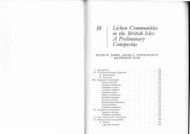You also want an ePaper? Increase the reach of your titles
YUMPU automatically turns print PDFs into web optimized ePapers that Google loves.
11* Thallus otherwise colored. Ap. very rare . 13<br />
12 Thallus thickly covered with brown ap, without<br />
isidia, thickly dwarf shrubby to almost cushionlike,<br />
round, usually up to 2 cm wide and 1(1.5)<br />
cm high, brown to dark brown, usually shiny,<br />
underside only a little lighter. Almost always on<br />
branches <strong>of</strong> birch, on planted Scots pine, wood. *<br />
. C. sepincola<br />
12* Thallus usually without ap., with marginal isidia<br />
or isidiate border soralia, usually <strong>of</strong> little erect<br />
irregularly curved, flat to concave, at the margin<br />
consisting <strong>of</strong> undulating lobes, brown-olive to<br />
dark brown, when moist olive-green, underside<br />
light brown to whitish, wrinkled.<br />
* C. chlorophylla<br />
13 Thallus deep yellow to citron yellow, medulla<br />
yellow, at the margin with swollen yellow border<br />
soralia, with close lying, ascending margins, -5<br />
mm wide lobes. Usnic acid, Vulpinic acid,<br />
Pinastrinic acid Vulpicida pinastri<br />
13* Thallus pale yellow-greenish or gray, bluish-<br />
gray, brown-gray. Medulla white . 14<br />
14 Thallus yellow-greenish to pale gray-greenish,<br />
undersides whitish to light brown, K-, P-.<br />
Medulla R-. Usnic acid, Protolichesterinic acid.<br />
Rare montane/high montane species. Lobes -5<br />
mm wide . 15<br />
14* Thallus gray, bluish-gray, on exposed sites even<br />
browned, undersides brown to black, with age<br />
also white, usually large, lobes 0.5-2 cm wide.<br />
Cortex K+ yellow. Atranorin 16<br />
15 Thallus undersides brown, without pseudocyph.,<br />
<strong>of</strong>ten with border soralia at the margin, robust,<br />
rather close lying. Pycnosp. 7-11 x 0.8-1 µm.<br />
Caperatic acid, (Lichesterinic acid)<br />
* C. oakesiana<br />
15* Thallus underside whitish to light brownish, with<br />
isolated rounded pseudocyph., border soralia<br />
<strong>of</strong>ten scarcely developed, thallus segment usually<br />
clearly ascending at the margin. Pycnosp. 3-4.5 x<br />
0.5-0.8 µm. * C. laureri<br />
16 Thallus upper side without scattered white<br />
puncti, smooth to <strong>of</strong>ten unevenly wrinkled,<br />
sometimes dark flecked, lobes broad, <strong>of</strong>ten<br />
curved, commonly not uniformly rounded,<br />
strongly incised, <strong>of</strong>ten strongly ascending, at the<br />
margins with soralia and/or coralloid isidia (then<br />
<strong>of</strong>ten crinkled) or naked, underside dark brown to<br />
black or black flecked, in moist sites even white<br />
flecked or almost entirely white, with only<br />
isolated rhizines. Medulla R-. Caperatic acid *.<br />
Very variable species, commonly with<br />
Pseudevernia and Hypogymnia physodes .<br />
Platismatia glauca<br />
16* Thallus upper side with fine white, scattered<br />
puncti or short elliptical flecks (Pseudocyph.),<br />
smooth, with broad, regularly rounded lobes, at<br />
times bordered with white swollen border soralia<br />
and above all here ascending, undersides black,<br />
with scattered rhizines, brown at the margin,<br />
without rhizines (Cetrelia olivetorum s.l.) . 17<br />
17 Medulla C-, KC- or KC+ rose, K-, P-. ±<br />
Perlatolic acid, ± Imbricaric acid.<br />
* Cetrelia cetrarioides<br />
17! Medulla C+/KC+ rose-red, K-, P-. Olivetoric<br />
acid * . Cetrelia olivetorum<br />
17* Medulla C-, KC+ rose, K-, P-. α-Collatolic acid,<br />
Alectoronic acid * . Cetrelia chicitae<br />
Ecology and Distribution <strong>of</strong> the Species<br />
(Allocetraria Kurokawa & Lai)<br />
Cetraria oakesiana Tuck. (Allocetraria o.<br />
(Tuck.) Randl. & Thell)<br />
In high montane, oceanic, very high precipitation<br />
sites usually on conifer trees (spruce, fir),<br />
commonly at the trunk base, on relatively<br />
constant, v.-e.humid, cool, rather long time snow<br />
covered habitats in the interior <strong>of</strong> beech-spruce<br />
and spruce-fir forests, mostly in the<br />
neighborhood <strong>of</strong> brooks and water falls,<br />
r.acidoph., m.photoph.(-r.skioph.),<br />
substrathygroph., anitroph., e.g. with<br />
Menegazzia, Bryoria bic. (↑) - mieur-pralp –<br />
v.rare (1); süSch (2x), Al<br />
(Cetraria s. str.)<br />
Cetraria aculeata (Schreber) Fr. (Cornicularia<br />
a. (Schreber) Ach., C. tenuissima (L.) Zahlbr.,<br />
Coelocaulon aculeatum (Schreber) Link)<br />
In hill and montane, usually low precipitation to<br />
moderately high precipitation sites on sandy soil,<br />
level, sandy or fine gravel acid loam and stony<br />
soil, even on calcareous soils, in openings in<br />
silicate and lime turfs (Nardo-Callunetea,<br />
Festuco-Brometea), in rock debris community.<br />
(Seslerio-Festucion), in sandy meadow<br />
(Corynephorion), in open Scots pine forest, stony<br />
oak forest (Luzulo-Quercetum), always on well<br />
lighted usually warm summer, sunny sites on dry<br />
soil with sparse vegetation, v.acidoph.subneutroph.,<br />
r.xeroph., r.-v.photoph., Char.<br />
Cladonion arb., above all in Cladonietum fol. –<br />
bor-med-mo – rare (2); above all RhSch and Pf,<br />
also Vog, He, Th, Fr, v.rare nöRh, Rh-Mn-T,<br />
Sch, O, Sp, Ju, Ries etc.<br />
Cetraria ericetorum Opiz (C. crispa (Ach.)<br />
Nyl., C. tenuifolia (Retz) R.H.Howe)<br />
Like C. cucullata (↑), yet also on less extreme<br />
wind exposed sites and more <strong>of</strong>ten even in<br />
153





